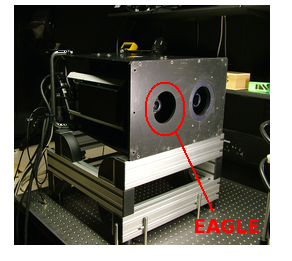Eagle Hyperspectral Sensor
The Eagle sensor is a visible to near infra-red hyperspectral instrument manufactured by Specim. It operates as a separate instrument, but complimentary with, the Hawk hyperspectral instrument.
Raw data format
The Eagle data is captured as ENVI format BIL files (a pair of .hdr and .raw), with an associated nav file (usually one nav file per project). The .hdr files are ASCII text files where as the .raw and .nav are binary data files.
The Eagle .raw data files contain 12-bit data (values of 0-4095) stored as 16-bit integer. The first pixel of the first band of each raw file is the frame counter pixel, which is essentially a frame id tag that increments by 1 through out the file. At the end of the raw file, after data capture for this flight line, a number of lines of data are captured with the shutter closed. These lines are referred to as "dark lines" and give sensor ccd values for when no light is present.
The .nav files are a collection of different 'messages'. These contain the real-time position and attitude of the aircraft as well as periodic time stamps marking the start of the flight line capture.
Data transfer
The data from the CCD are transferred to a framegrabber card in the computer using Camera Link. As this is a digital protocol, there are no digitisation effects to worry about. However, there may be some digitisation error in the camera itself.
Timing
See also: Sensors/SpecimNavSync
The Eagle instrument is connected to a nav-sync box that timestamps the start of acquisition against GPS time. This measures the time to the next GPS pulse-per-second, from the first start of integration pulse from the camera that occurs after the start of acquisition pulse from the recording system.
The frame grabber lag time is unknown. Previously it was thought to be 55ms regardless of frame rate (i.e. a frame is captured 55ms before the nav sync pulse), but this was actually a once-off correction applied by Specim for a single dataset. What was called the frame grabber lag time is actually an unknown timing error in the system. Further work is underway to isolate this.
Consequently the timing of a start of acquisition is next_GPS_PPS - navsync_time - <unknown and variable error>ms.
Specifications for Eagle SN100022 - Operated in period 2006 - 2012
| Detector size | 1024x1024 |
| Bit depth (of sensor analog to digital converter) | 12 bit |
| Spatial pixels | 1024 (unbinned) leftmost 71 dedicated to FODIS, leaving 953 for imagery |
| Spectral pixels | 1024 on CCD, central ~504 in use, normally binned by 2 in operation |
| Spectral resolution | 3.3 nm |
| Nominal spectral range (prior to calibration) | 400-970nm |
| Central pixel number | 512 (of original 1024, unconfirmed) Once FODIS region is stripped, this is pixel no 440 (unconfirmed) |
| Focal length | 18.3mm (manufacturer supplied) (18.5mm on manufacturer datasheet retrieved 20090817 - http://www.specim.fi/products/aisa-airborne-hyperspectral-systems/aisa-series.html |
| Field of View (FOV) | 37.7 degrees (from manufacturer datasheet retrieved 20090817 - http://www.specim.fi/products/aisa-airborne-hyperspectral-systems/aisa-series.html Note the FOV is lopsided as the FODIS region removes a couple of degrees on the starboard side |
| Pixel size | 12 micrometers (unbinned) |
| IFOV | 0.037 degrees (from manufacturer datasheet retrieved 20090817 - http://www.specim.fi/products/aisa-airborne-hyperspectral-systems/aisa-series.html |
The smile and keystone are <2 microns, according to the datasheet.
Note that the field of view and focal length parameters are not measured but are quoted from specifications or mathematically calculated by the manufacturer, so there will be some error.
A portion of the CCD (pixels 0-71, peaking around pixel 36?) is connected by a fibre optic cable to the FODIS, which collects downwelling light.
Specifications for Eagle SN110001 - Operated in period 2013 - 2014
| Detector size | 1024x1024 |
| Bit depth (of sensor analog to digital converter) | 12 bit |
| Spatial pixels | 1024 (unbinned) |
| Spectral pixels | 1024 on CCD, central ~504 in use, normally binned by 2 in operation |
| Spectral resolution | 3.3 nm |
| Nominal spectral range (prior to calibration) | 400-970nm |
| Central pixel number | 512 (of original 1024, unconfirmed) |
| Focal length | 18.184mm (from manufacturer calibration report received 2013) |
| Field of View (FOV) | 37.19 degrees (from manufacturer calibration report received 2013) |
| Pixel size | 12 micrometers (unbinned) |
| IFOV | 0.036 degrees (from manufacturer calibration report received 2013) |
Max keystone 0.33 pixels (from manufacturer calibration report received 2013)
IFOV Calculations
Using the 2 * tan-1( PIXELSIZE / 2 * FOCAL_LENGTH) calculation from http://www.fas.org/man/dod-101/navy/docs/es310/EO_image/EO_Image.htm, you get:
- 0.03771002 degrees, using 18.3mm for the focal length
- 0.037165 degrees, using 18.5mm for the focal length
Using the FOV / number of pixels method, you get:
- 0.036816406, from FOV / 1024 (raw sensor spatial pixels)
- 0.03960084, from FOV / (1024 - 72) (raw sensor spatial pixels minus FODIS region) - most likely to be wrong of all these.
Attachments (1)
- eagle.png (145.7 KB) - added by emca 14 years ago.
Download all attachments as: .zip
